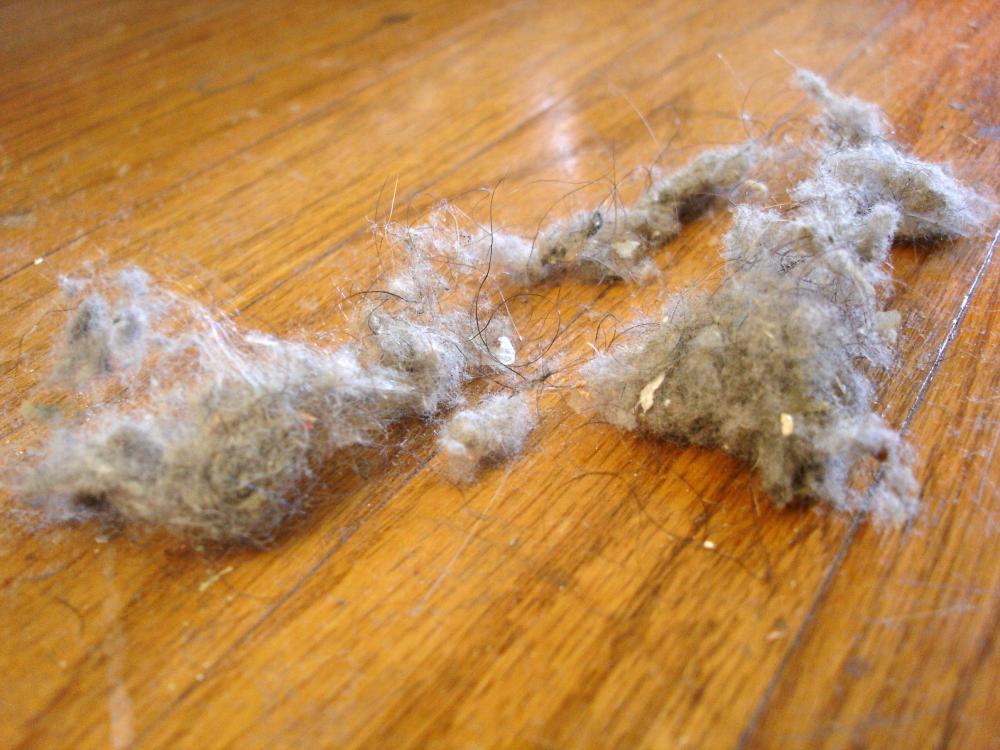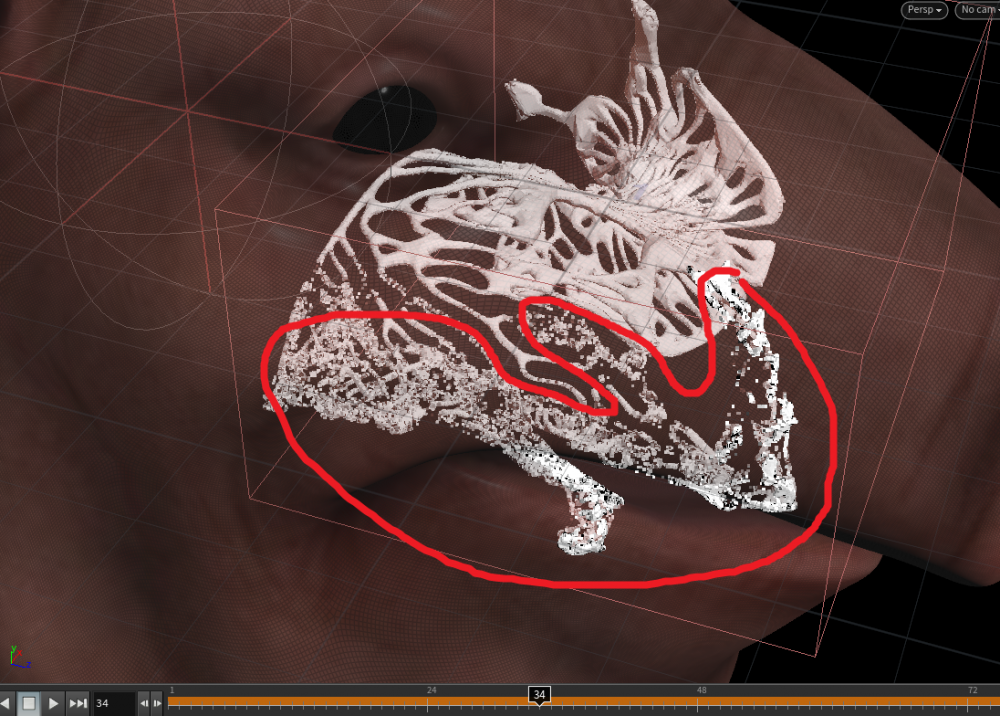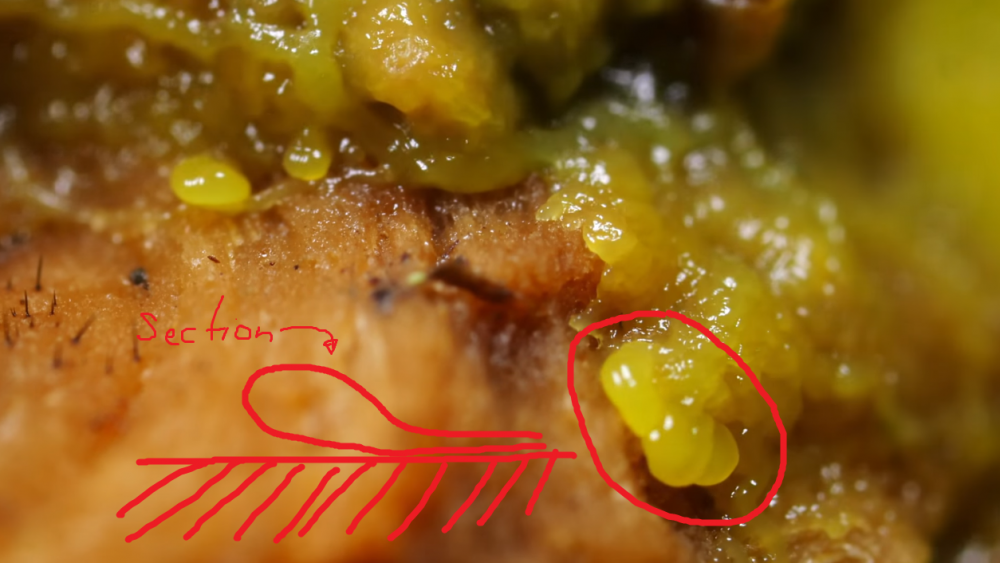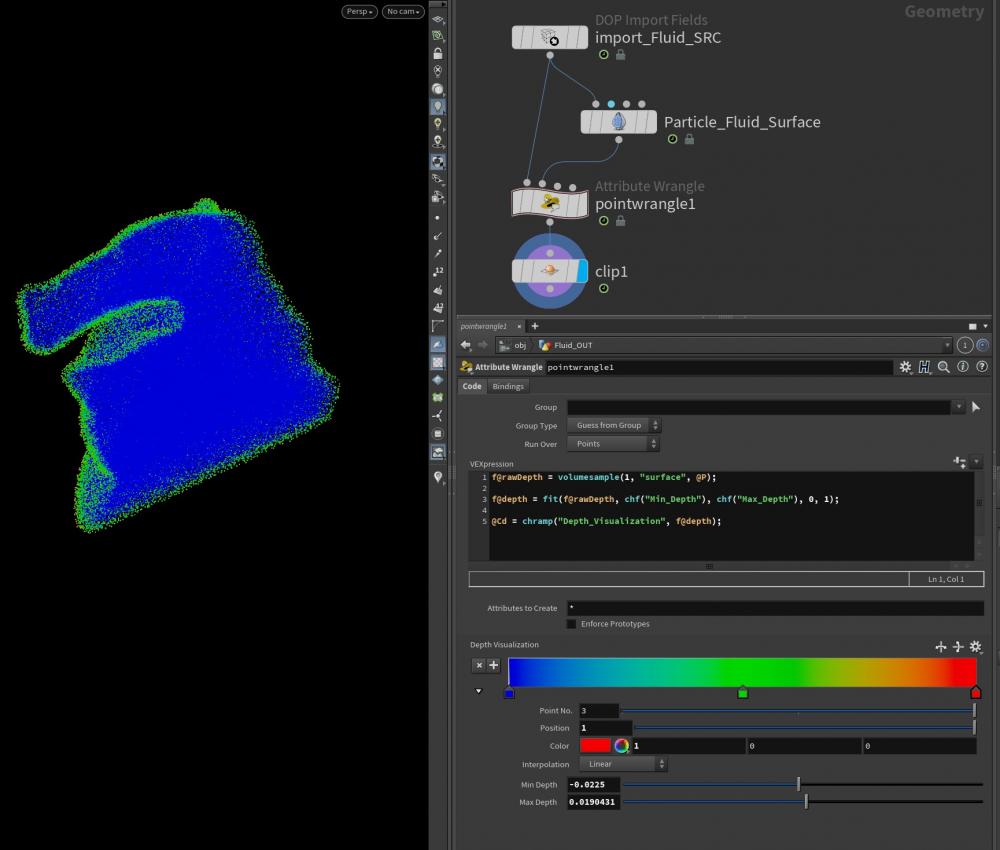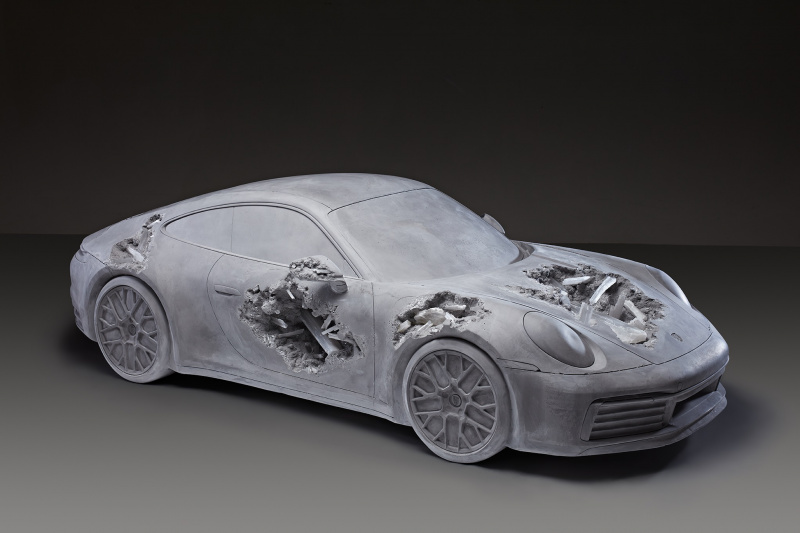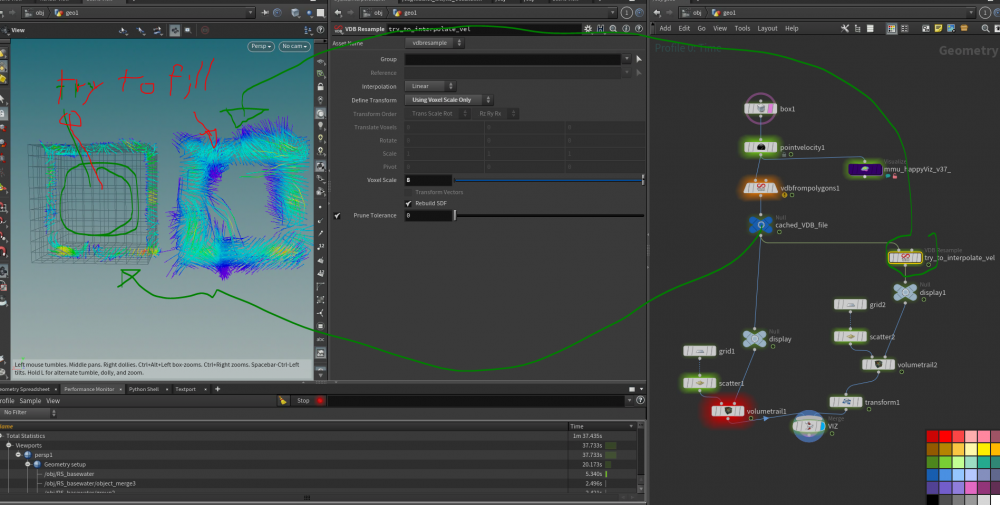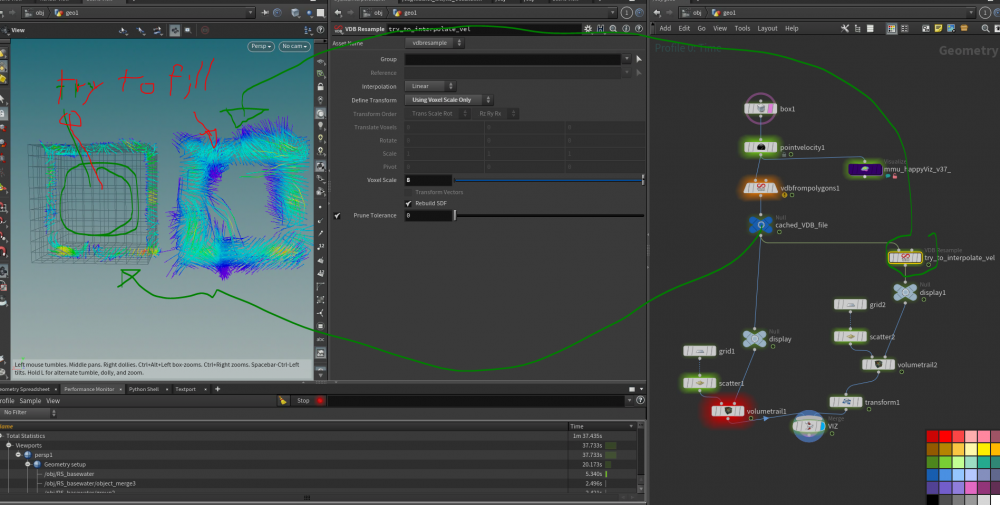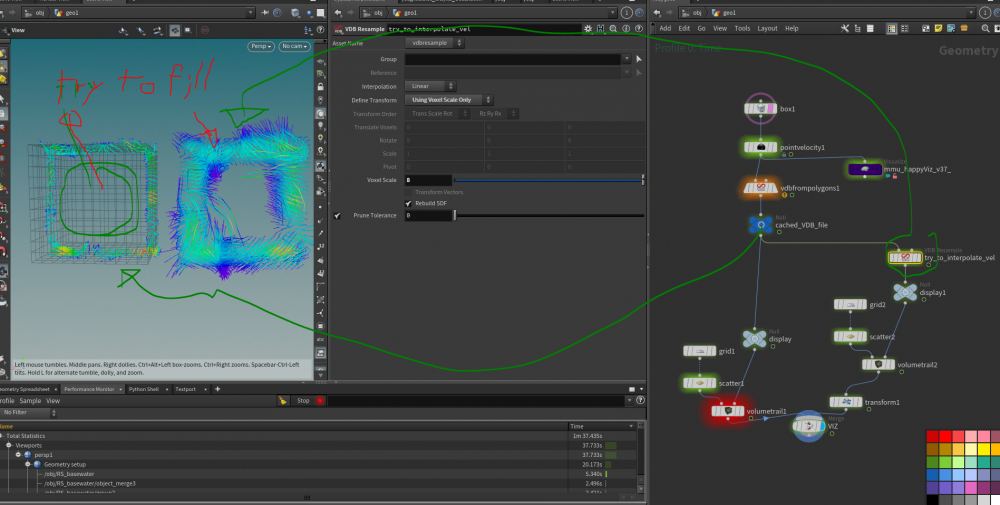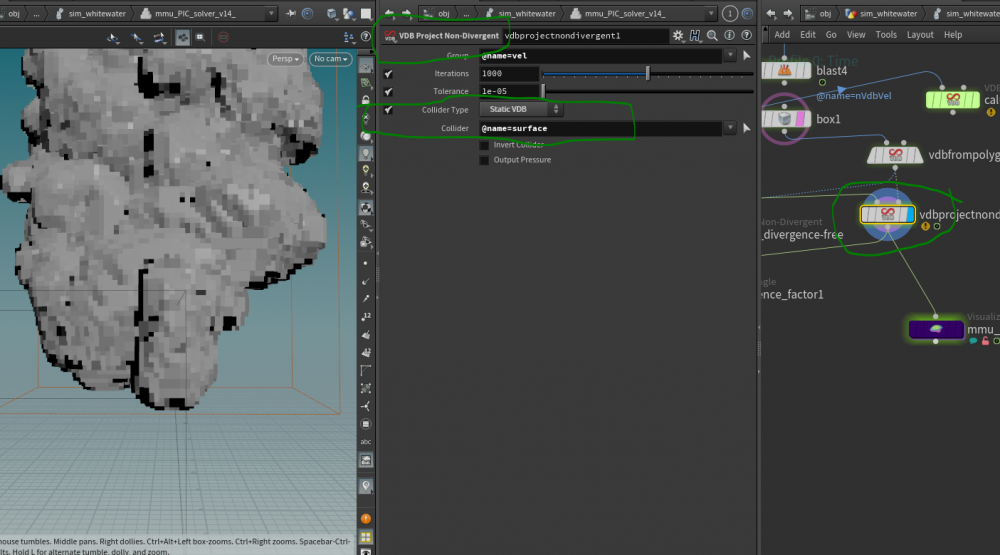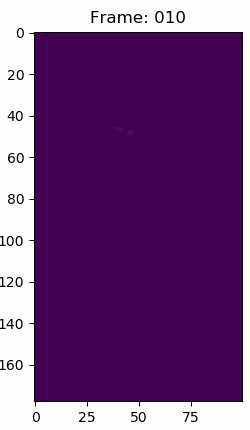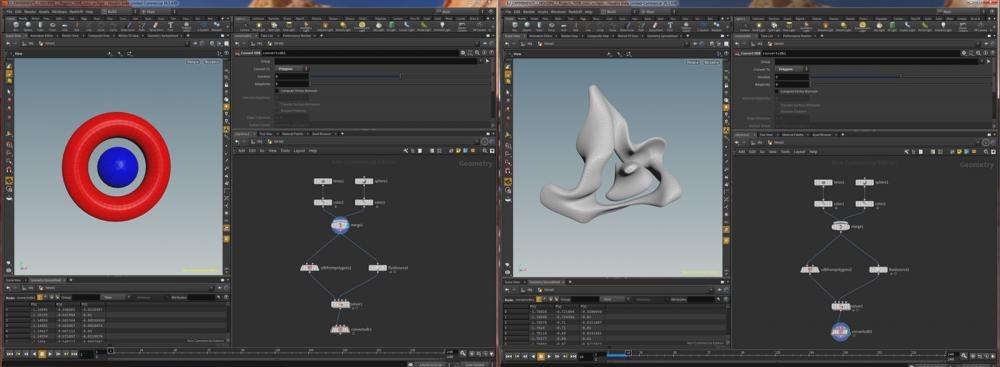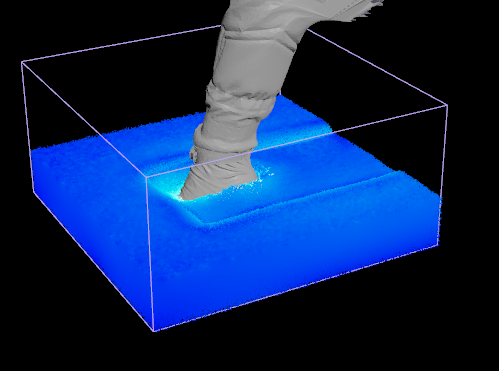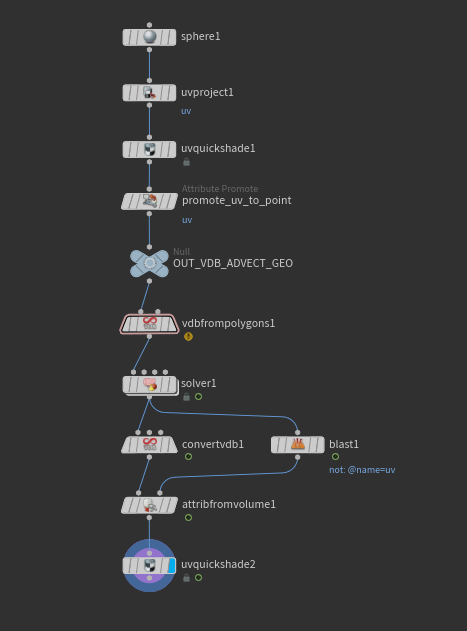Search the Community
Showing results for tags 'vdb'.
-
Hi, we are turning some animated geometry (alembic, non-deforming animation) into clouds, but because we want the noise of the clouds to be in local space (not be affected by the animation), I am trying to work out how to apply the animation after the creating the clouds referencing the intrinsic transform of the alembic. Using an AttributeVOP, I've managed to copy the intrinsic:packedfulltransform of the animated alembic, on to the intrinsic:transform of the static alembic model. I am still trying to get my head around the difference between matrix3 and matrix4 for these transform. Is there a general rule to which matrix type is used in each case? intrinsic:packedfulltransform is matrix4, intrinsic:transform in packed primitives is matrix3, but intrinsic:transform in VDB is matrix4. So what I put together and works for packed geometry or simple volumes, doesn't work with VDBs unless if I pack them before hand. Also my understanding is that intrinsic:packedfulltransform and intrinsic:packedlocaltransform are not writable and I can only change intrinsic:transform . Is that right? thank you
-
Hello all, I am struggling to get proper UVs to move along with this vdb surface advection (courtesy of artist Jose Leon Molfino). I assume you would just make the UVs the same as the rest attributes but I am not getting the same results (as the video I attached). There is not much out there for blending dual rest and adding UVs to a growth simulation. If someone knows the solution it would be a great help to my personal project!! I attached Jose's file below which I would like to figure out how to add UVs too. Thank you very much! https://x.com/Jose_Molfino/status/1585375392101064704?s=20 ssstwitter.com_1697331574695.mp4 vdb_advection_withoutUVs.hipnc
-
Hello, I'm new here. I've been trying to achieve a close-up look of liquid, similar to the crown title sequences. I'm not sure if it's created using VDB, FLIP, or a mix of both, but I'm stuck at the moment. Could anyone suggest other methods I should try? I'm specifically aiming for the look seen at the 11-second mark where the liquid is filling up in close-up. Thanks in advance!
-
- simulation
- vdb
-
(and 1 more)
Tagged with:
-
When you create the collision vdb for a flip simulation or a pyro simulation or a pop simulation, do you turn on Fill Interior or not? And why? The Static Object and Deforming Object shelf tools don't turn it on. Does that mean that this should be the proper way? Are there such scenarios where you specifically need to turn it on or off for your collision to be working properly? I am full of doubts.
-
- vdb
- fill interior
-
(and 1 more)
Tagged with:
-
Any effective way to create this kind of dust. I used Cloud noise but doesn't seem to look preety well. any suggestion will be helpful. Thanks
-
Hello everyone, Wondering if someone has suggestions on how to achieve this level of details with Houdini? I tried with grains, displacement, geometry, textures... I can't seem to get it to look right. VDB's seem to be quite versatile to achieve some of the general textures and shapes, but the end results is always too round and soft. Looking for: - Fine powder - Sharp cracks and fractured pieces - Mix of smooth and crumbled / rough areas - Small random chunks Are there suitable techniques I am missing or out of luck for this level of details? Thanks!
-
Hi everyone, so lately i've been experimenting in order to create something like this growth effect. Herradura Legend_Case Study.mp4 I've wanted to achieve that growing effect with ripples that goes along the effect (i really have no idea how to achieve that rippling effect). Here is the Hip file in which i've done the masking along the test geo. VDB advection growth_Dev01.hiplc Any help would be appreciated and thank you in advance.
- 1 reply
-
- vdb
- vdb advection
-
(and 1 more)
Tagged with:
-
Hello houdini guys, Im trying to simulate physarum polycephalum growth, but unfortunately it has some small issues. I would like to ask U on 3 main questions, if u will able to help me with any of them, it will be very helpful for me! 1. I have problem with VDB convertion as U can see on the picture, the distributed mesh (from wire extrude) is broken and VDB looks like particles. I dont know how to fix that. 2. In my file (I marked it with red network box) the small vein system of my slime mold, and I would like to connect it to the growing solver, but I dont know how. Basically I need this small veins with same growing properties like the big one have. 3. And last one is is possible to make the slime mold more "fat" on the edge? I dot hnow how to select this part of mesh? :/ ( like onreference picture) Thank U guys for any advices! Im looking forward! Bye! Physarum.hip
-
Hi guys, I need the distance (depth) of each point from the surface of a FLIP-Fluid surface. 1) First, I tried to use the "surface" primitive attribute of the Flip-Fluid simulation output (as it is) in a point wrangle, but it didn't work. 2) Then I converted the particles to VDB using "vdbfromparticles" SOP, now I don't know what value should be set for the "Voxel size" and "Point Radius Scale"... 3) Finally I converted the particles to an SDF surface using the "particlefluidsurface" SOP. It works but I think this is not a good workflow to achieve the depth value of points, right? So, what is the best way to convert the Flip-Fluid particles to an SDF? Thanks for helping. Depth from FLIP_Fluid.hip
-
Hi, I am having a question about collider type option in vdb projection nondivergent SOP. A basic method is working well, and I try to use input2's optional collider VDB slot with collider type. I am expecting projection of non-divergence should happen only outside of collider or get influence of collider's velocity. However, it's nothing happen or getting error. I am guessing input2 should have a certain format to plug in object. If anyone knows how to use that feature properly, I would appreciate it, thanks!
-
- collider in vdb project non divergent
- collider
- (and 7 more)
-
Hey guys, I've always liked the works of Daniel Arsham. He tends to do a lot of eroded pieces with some sort of crystals, usually. I was wondering if anyone had suggestions on how I can create stuff like the pictures below in Houdini. I have used booleans in c4d with a displaced sphere/object but found it not looking as detailed/nice as I would have liked. It also takes quite a bit of time to create each individual object that's put in the boolean. In Houdini, I thought of converting geometry to a VDB then putting it in a volume VOP with some sort of noise and subtracting it from the volume, then converting back to geo. But I'm not too experienced with Houdini tbh and was looking for suggestions on the details of a potential setup.
-
Hello, I am trying to make a shelled object with a thickness (so negative space outside and inside, but the thin shell is positive space for collisions) collide with a FLIP fluid sim. Essentially imagine an egg with some fluid inside. The fluid would stay inside until cracked. After that point the water spills out and the collisions of the shell are all accurate before and after the crack. The problem im facing is that VDB creates only either a fully encased volume where anything thats inside the egg is negative and outside is positive or vice versa. I cant seem to make it recognize that the shell is the only thing it should be making a VDB volume out of and treating everything else as the outside. I can turn on the invert sign on the collision for FLIP and it kinda works but then once the egg cracks it just all goes haywire. So Im not sure how to approach this. I have also tried to create two VDBs with slight offset and combine them with the multiply function. Which in volume slice shows as a narrow band but the FLIP particles dont seem to like it at all. I have attached a simple file to show what's happening. Water_test.hiplc
-
Is there an easy way to blend two vdbs using for example a gradient on the Y axis? i have a displaced fog vdb and i want the displacement to happen in a certain area. Can i control that with a mask somehow inside the volume vop or do i need to blend the fog vdb without the displacement? Any workflow tips?
-
Multiple colors swirling in a blob of paint?
TwinkleToes posted a topic in General Houdini Questions
Hi guys. I'd like to have 2, maybe 3 colors of paint swirling in the blob. How do I go about that? Attached is the hiplj_paintblob_flipsim_test (1).hiplc file. -
Hi there, I want share for free my HDA for combine and export the cache of fluid from cluster system and convert it in VDB. Download here It's a open HDA so you can edit it if you want, please let me know if you do/did it and let me know if you use it in production. It's free, but a little donation is grateful Have a nice day Matteo video demo https://youtu.be/dLj2CaWam7Q
-
Hi! I have a question about VDB vel. Let's say there is a a "cached VDB" sdf and vel where vel exists only around surface. Then I try to fill out vel inside. If you have a good idea, let me know, thanks!! (sorry, I uploaded the same pic by mistake, and cannot get rid of that...)
-
Hi, I am trying to figure out how to use VDB Project Non-Divergent > Collider Type. I am expecting input1's vel will react/bend against Input2 volume. So far it's possibly working with Collider Type > Bounding Box. However, when using Collider Type > static VDB and Dynamic VDB, there is no change in input1's vel field. Also, I am not sure what volume name should select in Collider Type > Collider. It would be surface or vel ?? If anyone knows how to use static/dynamic VDB collider with input2 properly, I appreciate that, thanks ! Hi,
-
- vdb project non-divergent
- divergent
- (and 3 more)
-
I have a dataset that contains animated volumetric smoke density. The dataset is stored as NPZ files (numpy array save file). How can I load the density of a saved smoke simulation as an animated volume to render it ? For context about the float data in the volumes. This is what simulation number 70 snapshot 150 looks like in matplotlib with a viridis color map, but the data in each voxel are simple float64 values. The other snapshops and simulations look similar. This is how you load a single npz file, if you want to try it with the dataset. It just generates a generic numpy float array. So you could just make a tiny numpy array filled with random data yourself for the purpose of testing like this np.random.rand(3,3,3). import numpy as np def npz_to_nparray(filepath): """ loads npz file from location :param filepath: string to file location :return: numpy array """ data = np.load(filepath) data = data[data.files[0]] # normal strange operations to get the the actual array inside data = np.transpose(data, (3, 1, 0, 2)) # turning the inner array layer outside and rightside up return data[0] I have tried: -I can load the npz files in python and in Houdini's python shell as a numpy array. I dont know how to put the data into a Houdini volume or which file format Houdini needs to import it. -I tried to translate the npz files to vdb with the pyopenvdb libary for python. But after multiple days of trying I am unable to import pyopenvdb. I build pyopenvdb library on windows with vcpkg and cmake, but I cannot import the build package. I setup an ubuntu VM and tried importing pyopenvdb there, but I can not import it. tl;dr: How to import animated smoke voxel data that is currently stored as a 4D python array?
-
Hi, I am in the process of setting up a sky full of clouds - using VDBs. I have set up an early proof-of-concept test, can render it, and it all works out of the box. What I'm struggling with is how to maximally optimize it. I have seen an Arnold setup in Houdini, similar to mine, with 3000 cloud objects - using ass files and rendering an HD1080 frame in around 5 minutes, and using less than 100Mb of memory. Pretty efficient! My Redshift test, has a similar number of VDBs exported out as a single rs proxy which is then instanced across scattered points on a grid. I expected this to speed up the rendering process significantly. Sadly, it actually takes over 4 hours at the same resolution and uses more than 5Gb of memory! What I want to do is leverage the power of proxies and instancing to render this setup and at least match what can be done in Arnold - Redshift is after all a definitively faster render engine. Does anyone know an efficient and effective workflow for this type of solution please? I feel like I've missed something here; as usually Redshift is very fast. Many Thanks, Scott
-
Hi, I'm trying to pass the color from polygon to VDB, transform the VDB then apply the color back to polygon but I don't know how to do. I tryed to use "VDB advect points" but I can't figure out how it's working and if it's the right solution. Charles VDB_color_uv.hipnc
-
Hey guys, I'm having some issues with a FLIP collision, seems my VDB collider boundaries are affecting the sim, anyone knows what can be causing this? I'm using static object + static solver with a proxy volume as collider. Thanks!
- 7 replies
-
- vdb
- boundaries
-
(and 2 more)
Tagged with:
-
At 13:52, this video briefly glosses over using simple geometry to add temperature to a specific area of an explosion: This is pretty much exactly what I want to achieve. The setup looks simple enough, except for an attribute wrangle where he doesn't show what's happening. Does anyone have any idea how he might be doing this? (Any other methods are welcome too!)
-
Thanks in advance for the help! I'm advecting a vdb so it grows over time. Once turned back into polygons, I'm hoping to stick UV's on it. The setup - I promote my uv's to point attribute and in the initial "VDB from polygons" I created a new surface attribute to store the uvs - I advect both vdb volumes in a sop solver, and then convert the vdb to polygons. - I then use an "attribute from volume" node to transfer the uv's from the volume onto the mesh. This works for the first frame, but as expected distorts and breaks down pretty quickly as the volume grows. I've researched and found examples of using the "dual rest fields" option in the Pyro and Flip Solver and then blending between the two rest states to "reset" the texture distortion as the mesh grows. There is a great example of this by Jesper Rahlff here (https://forums.odforce.net/topic/49461-lava-flow-question/?do=findComment&comment=227475). Great! I can create a rest field but... - What exactly is rest2? how is it different from rest1? - And how would I go about setting it up here without using the pyro or flip solver? If you have a better way to achieve this always open to that too VDB_Advect_UV_rnd_v02.hiplc
-
Hi everyone, I've an issue with vdb and i can"t find a way to solve this (so that's why i'm here haha) I'm working on a fluid simulation and i need to get the mesh into vdb to use it as collision surface. I'm trying to get a polygon mesh into vdb with the node vdb from polygone but there is holes and artefacts.. the issue is when i'm converting polygons into vdb with vdb from polygons there is a lot of holes into the vdb and I can't use it for my sim ( the particles goes through it). I think the problem comes from the mesh but I can't find what it is. (the mesh comes from Zbrush) I tried with a collision source node, same result as vdb from polygons. I can't find a way to get a clean vdb fron this mesh. So I wonder where those holes coming from and how can I fix it ? If someone have the solution, that will be great =D thanks a lot !



